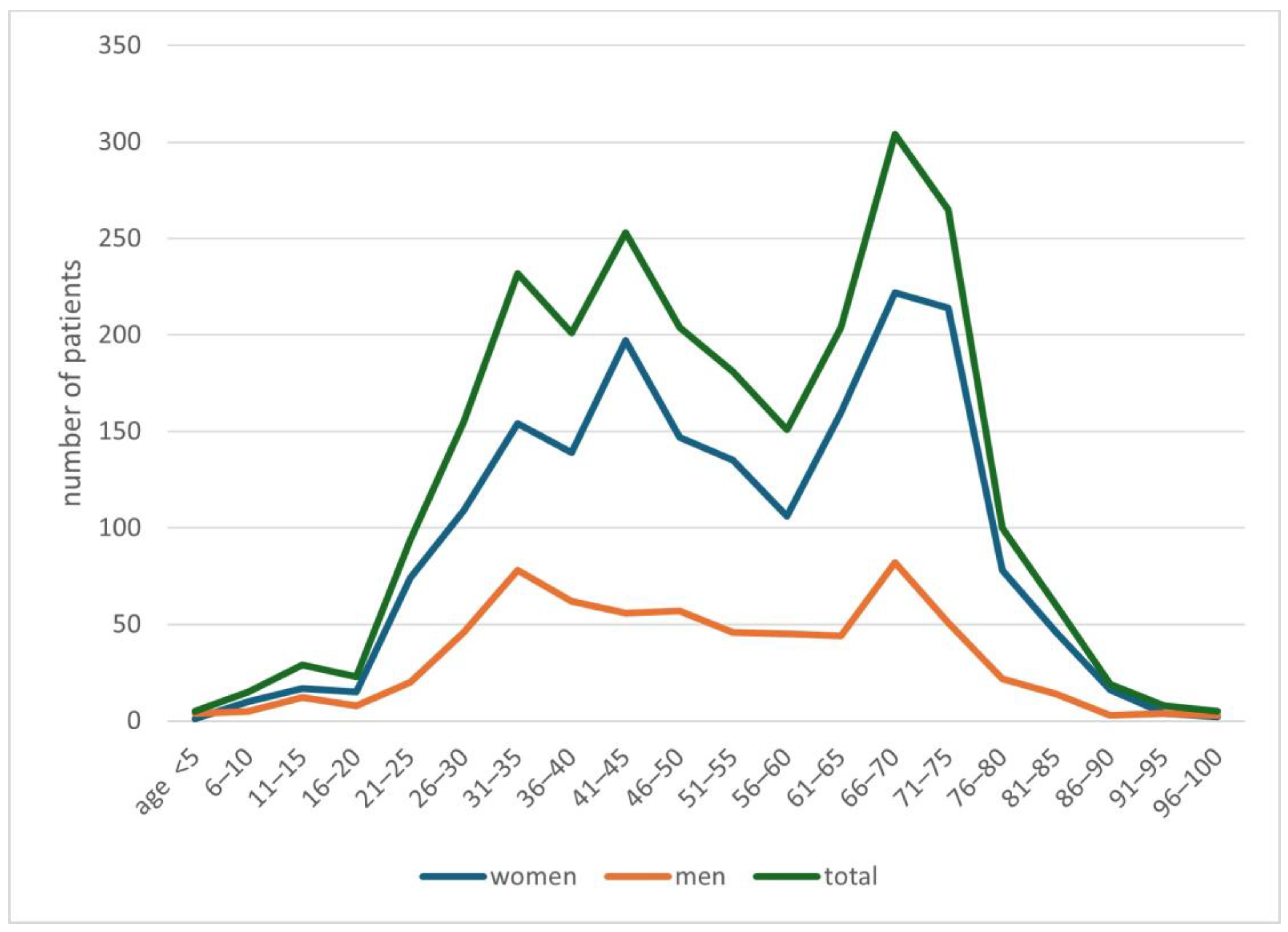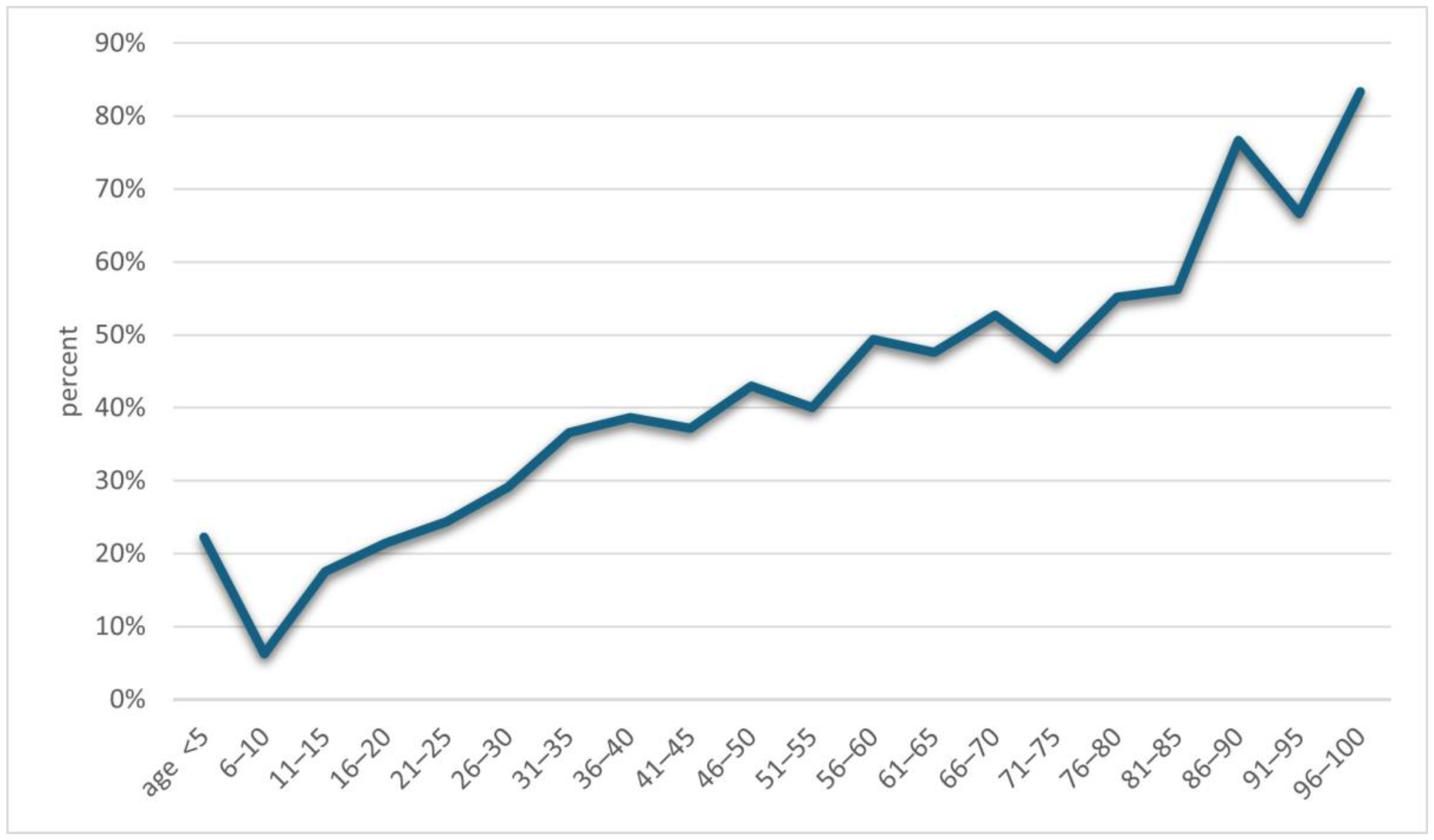The Prevalence of Demodex spp. Infestation in Dermatological Patients in Northern Poland
Abstract
1. Introduction
2. Materials and Methods
3. Results
4. Discussion
5. Conclusions
Author Contributions
Funding
Institutional Review Board Statement
Informed Consent Statement
Data Availability Statement
Conflicts of Interest
References
- Murphy, O.; O’Dwyer, V.; Lloyd-McKernan, A. Ocular Demodex folliculorum: Prevalence and associated symptoms in an Irish population. Int. Ophthalmol. 2019, 39, 405–417. [Google Scholar] [CrossRef] [PubMed]
- Paichitrojjana, A. Demodex: The worst enemies are the ones that used to be friends. Dermatol. Rep. 2022, 14, 9339. [Google Scholar] [CrossRef] [PubMed]
- Elston, C.A.; Elston, D.M. Demodex mites. Clin. Dermatol. 2014, 32, 739–743. [Google Scholar] [CrossRef] [PubMed]
- Foley, R.; Kelly, P.; Gatault, S.; Powell, F. Demodex: A skin resident in man and his best friend. J. Eur. Acad. Dermatol. Venereol. 2021, 35, 62–72. [Google Scholar] [CrossRef] [PubMed]
- Lacey, N.; Russell-Hallinan, A.; Powell, F.C. Study of Demodex mites: Challenges and Solutions. J. Eur. Acad. Dermatol. Venereol. 2016, 30, 764–775. [Google Scholar] [CrossRef]
- Wei, F.; Li, L.; Kong, Y.; Yan, X.; Varghese, K.J.; Zhang, S.; Jiang, J.; Chai, B.; Chen, H. Evidence for the Clinical Association between Demodex and Rosacea: A Review. Dermatology 2024, 240, 95–102. [Google Scholar] [CrossRef]
- Thoemmes, M.S.; Fergus, D.J.; Urban, J.; Trautwein, M.; Dunn, R.R. Ubiquity and diversity of human-associated Demodex mites. PLoS ONE 2014, 9, e106265. [Google Scholar] [CrossRef]
- Lacey, N.; Delaney, S.; Kavanagh, K.; Powell, F.C. Mite-related bacterial antigens stimulate inflammatory cells in rosacea. Br. J. Dermatol. 2007, 157, 474–481. [Google Scholar] [CrossRef]
- Aktaş Karabay, E.; Aksu Çerman, A. Demodex folliculorum infestations in common facial dermatoses: Acne vulgaris, rosacea, seborrheic dermatitis. An. Bras. Dermatol. 2020, 95, 187–193. [Google Scholar] [CrossRef]
- Lacey, N.; Ní Raghallaigh, S.; Powell, F.C. Demodex mites-commensals, parasites or mutualistic organisms? Dermatology 2011, 222, 128–130. [Google Scholar] [CrossRef]
- Yun, C.H.; Yun, J.H.; Baek, J.O.; Roh, J.Y.; Lee, J.R. Demodex Mite Density Determinations by Standardized Skin Surface Biopsy and Direct Microscopic Examination and Their Relations with Clinical Types and Distribution Patterns. Ann. Dermatol. 2017, 29, 137–142. [Google Scholar] [CrossRef] [PubMed]
- Aşkin, U.; Seçkin, D. Comparison of the two techniques for measurement of the density of Demodex folliculorum: Standardized skin surface biopsy and direct microscopic examination. Br. J. Dermatol. 2010, 162, 1124–1126. [Google Scholar] [CrossRef] [PubMed]
- Forton, F. Standardized skin surface biopsy: Method to estimate the Demodex folliculorum density, not to study the Demodex folliculorum prevalence. J. Eur. Acad. Dermatol. Venereol. 2007, 21, 1301–1302. [Google Scholar] [CrossRef] [PubMed]
- Bunyaratavej, S.; Rujitharanawong, C.; Kasemsarn, P.; Boonchai, W.; Muanprasert, C.; Matthapan, L.; Leeyaphan, C. Skin scrapings versus standardized skin surface biopsy to detect Demodex mites in patients with facial erythema of uncertain cause—A comparative study. Indian. J. Dermatol. Venereol. Leprol. 2016, 82, 519–522. [Google Scholar] [CrossRef] [PubMed]
- Sędzikowska, A.; Osęka, M.; Skopiński, P. The impact of age, sex, blepharitis, rosacea and rheumatoid arthritis on Demodex mite infection. Arch. Med. Sci. 2018, 14, 353–356. [Google Scholar] [CrossRef]
- Wesolowska, M.; Knysz, B.; Reich, A.; Blazejewska, D.; Czarnecki, M.; Gladysz, A.; Pozowski, A.; Misiuk-Hojlo, M. Prevalence of Demodex spp. in eyelash follicles in different populations. Arch. Med. Sci. 2014, 10, 319–324. [Google Scholar] [CrossRef]
- Garbacewicz, A.; Udziela, M.; Grytner-Ziecina, B.; Szaflik, J.P.; Szaflik, J. Demodex infections in general Polish population, in patients suffering from blepharitis, and among people who work with microscopes. Klin. Ocz. 2010, 112, 307–310. [Google Scholar]
- Karincaoglu, Y.; Bayram, N.; Aycan, O.; Esrefoglu, M. The clinical importance of demodex folliculorum presenting with nonspecific facial signs and symptoms. J. Dermatol. 2004, 31, 618–626. [Google Scholar] [CrossRef]
- Chen, W.; Plewig, G. Human demodicosis: Revisit and a proposed classification. Br. J. Dermatol. 2014, 170, 1219–1225. [Google Scholar] [CrossRef]
- Dopytalska, K.; Lipa, K.; Sobolewski, P.; Szymańska, E.; Walecka, I. Role of Demodex folliculorum in dermatology. Dermatol. Rev./Przegląd Dermatol. 2019, 106, 507–514. [Google Scholar] [CrossRef]
- Kim, S.; Min, H.S.; Lee, W.J.; Choe, S.A. Occupational differences in personal care product use and urinary concentration of endocrine disrupting chemicals by gender. J. Expo Sci. Environ. Epidemiol. 2023, 33, 312–318. [Google Scholar] [CrossRef] [PubMed]
- Åberg, E.; Kukkonen, I.; Sarpila, O. From double to triple standards of ageing. Perceptions of physical appearance at the intersections of age, gender and class. J. Aging Stud. 2020, 55, 100876. [Google Scholar] [CrossRef] [PubMed]
- Hsu, C.K.; Hsu, M.M.; Lee, J.Y. Demodicosis: A clinicopathological study. J. Am. Acad. Dermatol. 2009, 60, 453–462. [Google Scholar] [CrossRef] [PubMed]
- Chang, Y.S.; Huang, Y.C. Role of Demodex mite infestation in rosacea: A systematic review and meta-analysis. J. Am. Acad. Dermatol. 2017, 77, 441–447. [Google Scholar] [CrossRef]
- Veraldi, S.; Pisapia, A.; Nazzaro, G.; Boneschi, V. Unilateral rosacea, unilateral demodicidosis, unitaleral Demodex sp. folliculitis: Three names for the same disease. J. Cosmet. Dermatol. 2023, 22, 335–336. [Google Scholar] [CrossRef]
- Zhao, Y.E.; Hu, L.; Wu, L.P.; Ma, J.X. A meta-analysis of association between acne vulgaris and Demodex infestation. J. Zhejiang Univ. Sci. B 2012, 13, 192–202. [Google Scholar] [CrossRef]
- Akçınar, U.G.; Ünal, E.; Al, F.D. Demodex spp. as a possible aetiopathogenic factor of acne and relation with acne severity and type. Postepy Dermatol. Alergol. 2018, 35, 174–181. [Google Scholar] [CrossRef]
- Akkucuk, S.; Kaya, O.M.; Aslan, L.; Ozdemir, T.; Uslu, U. Prevalence of Demodex folliculorum and Demodex brevis in patients with blepharitis and chalazion. Int. Ophthalmol. 2023, 43, 1249–1259. [Google Scholar] [CrossRef]
- O’Dell, L.; Dierker, D.S.; Devries, D.K.; Garlich, J.; Whitley, W.O.; Holdbrook, M.; Baba, S.N.; Yeu, E. Psychosocial Impact of Demodex Blepharitis. Clin. Ophthalmol. 2022, 16, 2979–2987. [Google Scholar] [CrossRef]




| Total Number of Examined Patients | Patients with All Tests Negative | Patients with at Least One Test Positive | Total Number of Tests | Tests Confirming the Presence of Demodex spp. | |
|---|---|---|---|---|---|
| Total | 2508 | 1340 | 1168 | 3684 | 1585 (43.02%) |
| Women | 1846 | 1018 (55.15%) | 828 (44.85%) | 2797 | 1151 (41.15%) |
| Men | 662 | 322 (48.64%) | 340 (51.36%) | 887 | 434 (48.93%) |
| Age (Years) | |||||
|---|---|---|---|---|---|
| <18 | 18–40 | 41–60 | >60 | Total | |
| Patients | 56 | 698 | 789 | 965 | 2508 |
| Patients with all negative test results (% in a given age group) | 48 (85.71%) | 454 (65.04%) | 439 (55.64%) | 399 (41.35%) | 1340 (53.43%) |
| Patients with at least one test positive (% in a given age group) | 8 (14.29%) | 244 (34.96%) | 350 (44.36%) | 566 (58.65%) | 1168 (46.57%) |
| Location | |||||
|---|---|---|---|---|---|
| Result of Direct Examination | Facial Skin | Edges of Eyelids | Eyebrows | Hair | All |
| Total | 1710 | 1598 | 343 | 33 | 3684 |
| Positive | 580 (36.59%) | 889 (56.10%) | 108 (6.81%) | 8 (0.50%) | 1585 |
| Negative | 1130 (53.83%) | 709 (33.78%) | 235 (11.20%) | 25 (1.19%) | 2099 |
| Percentage of tests confirming the presence of Demodex spp. in particular locations | 33.92% | 55.63% | 31.49% | 24.24% | |
Disclaimer/Publisher’s Note: The statements, opinions and data contained in all publications are solely those of the individual author(s) and contributor(s) and not of MDPI and/or the editor(s). MDPI and/or the editor(s) disclaim responsibility for any injury to people or property resulting from any ideas, methods, instructions or products referred to in the content. |
© 2024 by the authors. Licensee MDPI, Basel, Switzerland. This article is an open access article distributed under the terms and conditions of the Creative Commons Attribution (CC BY) license (https://creativecommons.org/licenses/by/4.0/).
Share and Cite
Rychlik, K.; Sternicka, J.; Zabłotna, M.; Nowicki, R.J.; Bieniaszewski, L.; Purzycka-Bohdan, D. The Prevalence of Demodex spp. Infestation in Dermatological Patients in Northern Poland. Life 2024, 14, 1196. https://doi.org/10.3390/life14091196
Rychlik K, Sternicka J, Zabłotna M, Nowicki RJ, Bieniaszewski L, Purzycka-Bohdan D. The Prevalence of Demodex spp. Infestation in Dermatological Patients in Northern Poland. Life. 2024; 14(9):1196. https://doi.org/10.3390/life14091196
Chicago/Turabian StyleRychlik, Katarzyna, Julia Sternicka, Monika Zabłotna, Roman J. Nowicki, Leszek Bieniaszewski, and Dorota Purzycka-Bohdan. 2024. "The Prevalence of Demodex spp. Infestation in Dermatological Patients in Northern Poland" Life 14, no. 9: 1196. https://doi.org/10.3390/life14091196
APA StyleRychlik, K., Sternicka, J., Zabłotna, M., Nowicki, R. J., Bieniaszewski, L., & Purzycka-Bohdan, D. (2024). The Prevalence of Demodex spp. Infestation in Dermatological Patients in Northern Poland. Life, 14(9), 1196. https://doi.org/10.3390/life14091196







